Translational Perioperative and Pain Medicine (ISSN: 2330-4871)
ARTICLE DOI: 10.31480/2330-4871/059
RESEARCH ARTICLE OPEN ACCESS
Endothelin A Receptor Antagonist Alleviates Allodynia in a Rat Model of Complex Regional Pain Syndrome
Miao Qing1#, Er-liang Kong1#, Yan Zhang2, Hui-ting Di1, Yu-ming Sun1, Jin-min Zhang1, Wei-feng Yu1 and Fei-xiang Wu1
1Department of Anesthesiology, Eastern Hepatobiliary Hospital, Second Military Medical University, China
2Department of Anesthesiology, Zhoushan Hospital, Wenzhou Medical University, China
#Contributed equally
Wei-feng Yu, MD, PhD, Department of Anesthesiology, Eastern Hepatobiliary Hospital, Second Military Medical University, Shanghai 200438, China, Tel: 86-21-55063846, Fax: 86-21-25070783, E-mail: ywf808@sohu.com;
Fei-xiang Wu, MD, PhD, Department of Anesthesia & Intensive Care, Eastern Hepatobiliary Surgical Hospital, Second Military Medical University, Shanghai 200438, China, Tel: 86-21-55063846, Fax: 86-21-25070783, E-mail: feixiangwu@hotmail.com
Editor: Yuan-Xiang Tao, Ph.D., M.D., Professor and Vice Chair, Director, Center for Pain Medicine Research Department of Anesthesiology, Editor in Chief, The Translational Perioperative and Pain Medicine Rutgers, The State University of New Jersey, New Jersey Medical School, 185 S. Orange Ave., MSB, E-661 Newark, NJ 07103. Phone: 973-972-9812 (O) Email: yt211@njms.rutgers.edu
Received: July 04, 2017 | Accepted: September 12, 2017 | Published: September 15, 2017
Citation: Miao Q, Kong E, Zhang Y, Di H, Sun Y, Zhang J, Yu W, Wu F. Endothelin A Receptor Antagonist Alleviates Allodynia in a Rat Model of Complex Regional Pain Syndrome. Transl Perioper & Pain Med 2017; 4(4):13-17.
Abstract
Background
The traditional pharmacologic therapies for Complex Regional Pain Syndrome (CRPS) remain ineffective. Endothelin A (ET-A) receptor contributes significantly to the development and maintenance of pain in CRPS, and presents a target for novel therapies. We assessed the effects of the ET-A receptor antagonist BQ-123 on nociceptive sensitization, in a rat model of Chronic Post-Ischemia Pain (CPIP).
Methods
Mechanical thresholds and cold sensitization were evaluated in male Sprague-Dawley rats with CPIP. The effects of BQ-123 were assessed following intraplantar and intrathecal administrations, respectively. Activity levels were measured to evaluate potential side effects of BQ-123 on motor function.
Results
CPIP produced significant mechanical allodynia in SD rats from the first day, lasting for more than five days. Intraplantar administration of BQ-123 reversed mechanical and cold allodynia in CPIP rats. Meanwhile, intrathecal but not intraplantar pre-treatment with BQ-123 resulted in significant antiallodynic effects in CPIP rats. Motor impairment was observed in neither intraplantar administration nor intrathecal pre-treatment groups.
Conclusion
ET-A receptors play an important role in the process of nociceptive sensitization in CRPS, and the ET-A receptor antagonist BQ-123 demonstrated favorable therapeutic effects in CRPS.
Keywords
Endothelin a receptor, BQ-123, Chronic Post-Ischemia Pain (CPIP), Complex Regional Pain Syndrome (CRPS)
Introduction
Complex Regional Pain Syndrome (CRPS) is an uncommon form of chronic pain, and affects approximately 50,000 individuals in the United States annually [1]. CRPS is characterized by severe pain out of proportion to the initial injury, and accompanied by hypersensitivity, swelling, and changes in skin tissues. The pathogenesis of CRPS remains unclear, and is considered to be multi-factorial [2]. The factors suspected of causing CRPS include fractures (16% to 46%), ligament injury (10% to 29%), post-operation injury (3% to 24%), contusion and crush injury (8% to 18%), and others (2% to 17%) [3].
Suffering from intense pain and motor system dysfunction [4], CRPS patients commonly have a poor quality of life, with impaired mental health [5]. Meanwhile, traditional pharmacologic therapies for CRPS are ineffective in managing both the pain and associated symptoms [2]. Thus, it is important to elucidate the pathophysiologic features of CRPS and provide novel optimal approaches for CRPS management.
Endothelin-1 (ET-1), a vasoconstriction peptide, is considered to be involved in pain signaling pathways via activation of ET-A and ET-B receptors [6]. A study by Groeneweg, et al. [7] showed that the number of ET-1 positive cells increases significantly in the proximal limb of CRPS patients after amputation. ET-1 expression levels in skin blister exudates [8], plasma samples [9], and cerebrospinal fluid specimens [10] from patients with CRPS are increased compared with the values of patients without CRPS, strongly suggesting that ET-1 may be involved in the pathophysiology of CRPS.
It is well documented that ET-1 exerts its biological effects by interacting with ET-A and ET-B receptors. ET-A and ET-B receptors are widely distributed within the nervous system, from the sciatic nerve to the spinal cord and brain [11]. Meanwhile, ET-A receptors play a key role in pain pathways. Atrasentan, an ET-A receptor antagonist, was proposed for the treatment of chronic pain [12]. In this study, the effects of an ET-A receptor antagonist on CRPS were observed in a rat model of Chronic Post-Ischemia Pain (CPIP) to investigate novel potentials for managing CRPS.
Materials and Methods
Animals
This study was performed in accordance with the International Association for the Study of Pain guidelines for the use of animals in research, with the animal protocol approved by the Second Military Medical University Animal Care and Use Committee. Adult male SD rats (Shanghai Experimental Animal Center, Chinese Academy of Sciences) (260-280 g) were housed in a Specific Pathogen Free (SPF) environment (24 ℃ room temperature and 50% humidity) under a 12/12 hour light/dark cycle, with food and water ad libitum.
Establishment of the CPIP model
Based on the Terence J method, rats were anesthetized with chloral hydrate (300 mg/kg) by intraperitoneal administration [13]. An O-ring tourniquet was used at the proximal end of right hind ankle and loosened after 3 hours to allow reperfusion, to establish Ischemia Reperfusion (I/R) injury of the CPIP model. The same operation was performed in sham group rats without using the O-ring tourniquet.
Mechanical threshold measurement
Pain behavioral tests were performed before surgery and at 1 to 5 days post-operation. Mechanical threshold assessment was performed in both sham and CPIP groups. Moreover, CPIP and sham rats were treated with the ET-A receptor antagonist BQ-123 (10 µl, 10 nmol) or vehicle (10 µl) by intraplantar (i.pl.) administration. An Electronic von Frey (IITC Life Science, Woodland Hills, CA, USA) was used for mechanical threshold assessment. Rats were placed on a tawny suspended 22 × 22 × 30 cm cage to have the plantar surface of footpads stimulated with an electronic von Frey Rigid filament. The rigid filaments were applied to the paw surface, with the intensity gradually enhanced until paw withdrawal. The maximal value obtained during the procedure was recorded as mechanical threshold. The assays were repeated three times; a 5-minute interval was essential between two tests to avoid sensitization [14].
Cold allodynia measurement
Similar to mechanical pain threshold evaluation, after intraplantar administration of BQ-123 (10 µl,10 nmol) or vehicle (10 µl), cold allodynia in both CPIP and sham groups was assessed. Pyruvic acid (20 μl) was dropped on the soft parts of a hind paw, and the animal Acetone Exposure Behavious (AEB) was observed [15]. Criteria used for response evaluation were: 0: No response; 1: Paws licking, stomping and trembling (< 1 second); 2: Repeated paw licking, stomping, trembling and lifting (< 3 seconds); 3: Repeated paw licking, stomping and trembling (> 3 seconds); 4: Repeated paw licking, stomping, trembling and lifting (> 3 seconds).
Intrathecal catheter implantation
For intrathecal (i.t.) or intraplantar administration of BQ-123 (10 µl, 10 nmol) or vehicle (10 µl), both CPIP and sham groups were implanted the polyethylene catheter PE-10 (Becton, Dickinson and Company, USA), which was sterilized prior to surgery into the spinal subarachnoid space [16]. Following anesthesia by inhalation of 2% halothane, rats were placed on the operating table in the prone position. A 0.8-1.0 cm dorsal midline incision centered on the L5-L6 vertebral segment was made for lumbar intrathecal catheterization; next, a 4-5 mm hole was drilled in the left lateral aspect of the L4 or L5 vertebral body to expose the Dura mater. The sterilized catheter was then inserted into the intrathecal space and advanced rostrally 1.5-2 cm. Successful implantation was determined by observing the tail-flick reflex and cerebrospinal fluid flow from the catheter tip. The catheter was fixed tightly, with the opposite end led from the cervical region through a subcutaneous tunnel. All wounds were closed in multiple layers using appropriately sized long-absorbing suture materials, and 80 thousand units of penicillin were administered intramuscularly. After surgery, rats showing severe motor weakness and non-responsiveness to lidocaine were excluded from the study.
Qualitative measures of motor impairment
Although the current study used low dose of BQ-123 (10 µl, 10 nmol), we nonetheless elected to assess potential side effects of the drug, particularly since they could present potential confounding factors in data collection and interpretation. Side effects were measured by activity levels in the home cage 30 minutes after treatment by intraplantar administration, or by intrathecal pre-treatment with BQ-123 or vehicle on the third day after I/R injury [17]. Activity levels were: -3, anesthesia; -2, sedation; -1, drowsiness; 0: Normal; 1: Moderate impairment (disturbance in paw support); 2: Impairment (inability to maintain paw support, with the ability to regain an upright position after falling over); 3: Great impairment (inability to regain an upright position after falling over). Rats were observed for 10 minutes between 9:00 AM and 2:00 PM.
Data Analysis
Data are presented as mean ± standard deviation. Behavioral test data were analyzed by two-way repeated-measures ANOVA. P < 0.05 was considered statistically significant. All statistical analyses were performed with the SPSS 17.0 software.
Results
Mechanical thresholds in CPIP rats
Mechanical thresholds decreased rapidly on day 1 and reached a stabilized minimum on day 3 after I/R injury. Throughout the study, mechanical thresholds were lower in the CPIP group than sham animals (P < 0.05) (Figure 1), indicating that CPIP rats were more sensitive to nociceptive stimulation.
Figure 1: Time course of mechanical thresholds after Ischemia Reperfusion (I/R) injury in the CPIP model.
Mechanical thresholds decreased rapidly the first day, and reached a stable minimum on day 3 after I/R injury in the CPIP model. Throughout the measurement period, mechanical pain thresholds were lower in the CPIP group than in sham animals (#P < 0.05). CRPS: Complex Regional Pain Syndrome; CPIP: Chronic Post-Ischemia Pain; I/R injury: Ischemia Reperfusion Injury.
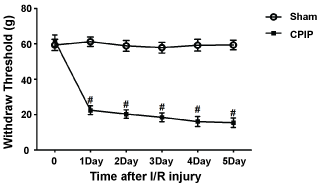
Effect of intraplantar administration of BQ-123 on mechanical thresholds in CPIP rats
Mechanical thresholds in the CPIP+BQ-123 group were increased compared with the value of the CPIP+veh group in the first 120 minutes (P < 0.05), and returned to baseline on day 6 (Figure 2). Meanwhile, no differences were observed between the sham+BQ-123 and sham+veh groups. These findings indicated that intraplantar administration of BQ-123 effectively relieved mechanical allodynia within 6 days.
Figure 2: Effect of intraplantar administration of BQ-123 on mechanical thresholds.
Mechanical thresholds were significantly increased in the CPIP+BQ-123 (i.pl.) group within 120 minutes of I/R injury (#P < 0.05, compared with the CPIP+veh [i.pl.] group), before returning to baseline on day 6. There were no differences between the sham+BQ-123 (i.pl.) and sham+veh (i.pl.) groups. CPIP: Chronic Post-Ischemia Pain; I/R injury: Ischemia Reperfusion Injury.
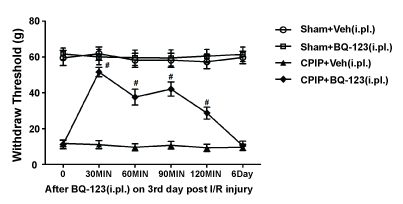
Effect of intraplantar administration of BQ-123 on cold allodynia in CPIP rats
As shown in Figure 3, cold allodynia scores were lower in the CPIP+BQ-123 group than in the CPIP+veh group 30 minutes after I/R injury (P < 0.05). No changes were observed between the sham+BQ-123 and sham+veh groups. These findings suggested that intraplantar administration of BQ-123 partially reversed cold allodynia.
Figure 3: Effect of intraplantar administration of BQ-123 on cold allodynia.
Cold allodynia was significantly reversed in the CPIP+BQ-123(i.pl.) group 30 minutes after I/R injury (##P < 0.01, compared with values before BQ-123 administration in the CPIP+BQ-123 [i.pl.] group; #P < 0.05, compared with CPIP+veh [i.pl.] group). CPIP: Chronic Post-Ischemia Pain; I/R injury: Ischemia Reperfusion Injury; AEB: Acetone Exposure Behavior.
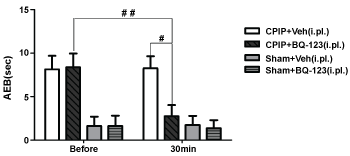
Changes of pain thresholds after intrathecal and intraplantar pre-treatment with BQ-123 in CPIP rats
Mechanical thresholds were somewhat higher in the CPIP+BQ-123 (i.t.) group than in the CPIP+veh (i.t) group (P < 0.05), while no significant differences were obtained between the CPIP+BQ-123 (i.pl.) and CPIP+veh (i.pl.) groups. No differences were observed in sham animals receiving intraplantar or intrathecal pre-treatment (Figure 4). These results indicated that central pre-treatment with BQ-123 reduced mechanical allodynia in the CPIP model, while local pre-treatment had no such effect.
Figure 4: Effect of intrathecal and intraplantar pre-treatment of BQ-123 on mechanical thresholds.
Mechanical thresholds were significantly increased in the CPIP+BQ-123 (i.t.) group compared with the CPIP+veh (i.t.) group (#P < 0.05); no differences were obtained between the CPIP+BQ-123 (i.pl.) and CPIP+veh (i.pl.) groups. CPIP: Chronic Post-Ischemia Pain; I/R injury: Ischemia Reperfusion Injury.
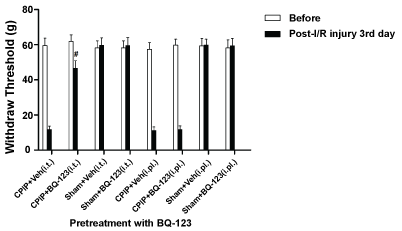
Motor impairment measurement
To assess whether BQ-123 administration results in overt side effects, activity scores in home cages were scored. No activity differences were observed between the vehicle and BQ-123 groups, whether after intraplantar administration (Figure 5A) or intrathecal pre-treatment (Figure 5B), indicating that BQ-123 did not cause motor dysfunction.
Figure 5: Motor impairment measurement.
Activity scores were close to the "0" level in all groups. No differences were observed between the vehicle and BQ-123 groups, whether after intraplantar administration (A) or intrathecal pre-treatment (B) (n = 10/group). CPIP: Chronic Post-Ischemia Pain; I/R injury: Ischemia Reperfusion Injury.
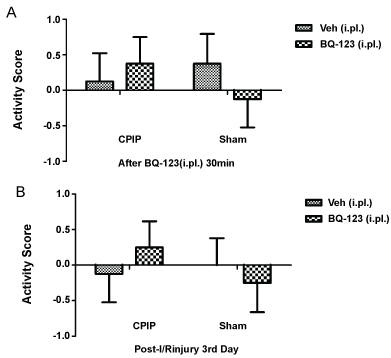
Discussion
In the current study, the effect of the ET-A receptor antagonist BQ-123 on nociception was observed, in a rat model of CPIP. The results indicated that intraplantar administration of BQ-123 effectively reduced mechanical and cold allodynia, suggesting that ET-A receptors play an important role in the process of nociceptive sensitization in CRPS. The ET-A receptor antagonist BQ-123 could potentially be used for CRPS management.
CRPS is considered a pain syndrome secondary to traumatic events and other injuries, including regional pain, sensory changes, skin color changes, abnormal body temperature, abnormal sweat secretion, and edema [2]. CRPS can be divided into distinct two types, including CRPS-I and CRPS-II. Patients without confirmed nerve injury are classified as CRPS-I (previously known as reflex sympathetic dystrophy syndrome). Meanwhile, subjects with associated, confirmed nerve injury are classified as CRPS-II (previously known as neuropathic pain). Despite the difference between the two types, treatment is similar, but ineffective. Indeed, no medications are specifically indicated for CRPS. Analgesics and narcotics are mostly used to treat the chronic symptoms of pain without favorable results. In rodents, ET-1 induced nociception can be reduced by systemic or central administration of morphine, but is resistant to other pharmacological drugs such as acetaminophen, indomethacin, dexamethasone, atenolol and ibuprofen [18].
In the present study, chronic post-ischemia pain was used to induce CRPS in rats. After 3-hour limb ischemia, rats showed nociceptive sensation in response to mechanical and/or cold stimulation, as well as limb congestion and edema. Sympathetic disorder symptoms were induced by the O-ring tourniquet on the tightened limb in the CPIP model without tibial nerve damage under microscopy, consistent with CRPS I. The rats showed allodynia in the present study, indicating that the CRPS model was constructed successfully.
Endothelial dysfunction is an important factor in the pathogenesis of CRPS. As an important regulator of cardiovascular function, ET-1 is found in the vascular endothelium, and exerts significant roles in vascular tone maintenance and homeostasis [9]. ET-1 in endothelial cells are involved in allodynia, movement disorders, amyosthenia, ataxia and edema [19], which may probably contribute to CRPS. Local ET-1 injections induce spontaneous pain in humans and rodents [20]. These effects are independent of its vascular activity, but rather involve the activation of C-nociceptors by increasing intracellular calcium levels [20]. Thus, ET-1 plays an important role in CRPS, and may present a possible target for CRPS treatment.
In the current study, BQ-123 was used as an ET-A receptor antagonist for managing CRPS in CPIP rats. A significant antiallodynic effect was observed, suggesting that intraplantar administration of BQ-123 had a significant therapeutic effect on CPIP. As ET-1 in the cerebrospinal fluid of CRPS I patients is upregulated, with ET-A receptors widely distributed within the central nervous system [11], it is possible that intrathecal (central) pre-treatment with BQ-123 may affect nociceptive sensitization in CPIP rats. Our results showed that pretreatment with BQ-123 intrathecally (centrally) relieved mechanical allodynia, whereas intraplantar (local) pretreatment exerted no effect in CPIP rats. These data suggested that ET-1 plays a role in nociceptive sensitization via central ET-A receptors. Therefore, intrathecal injection of ET-A receptors constitutes a possible tool for managing allodynia in CRPS.
Conclusion
The ET-A receptor antagonist BQ-123 alleviates allodynia effectively in a rat model of CPIP. ET-A receptor antagonists could potentially be used to manage intractable pain in CRPS.
Disclosure of Funding
This study was supported by grants from the National Natural Science Foundation of China (81671082) to Fei-xiang Wu, and the Xinchen Foster Fund for Anesthesiologists in Shanghai to Qing Miao.
Conflict Interests Disclosure
The authors have no conflicting interests to disclose.
References
- Mendez-Rebolledo G, Gatica-Rojas V, Torres-Cueco R, Albornoz-Verdugo M, Guzman-Munoz E. Update on the effects of graded motor imagery and mirror therapy on complex regional pain syndrome type 1: A systematic review. Journal of back and musculoskeletal rehabilitation 2016.
- Resmini G, Ratti C, Canton G, Murena L, Moretti A, Iolascon G. Treatment of complex regional pain syndrome. Clinical cases in mineral and bone metabolism : the official journal of the Italian Society of Osteoporosis, Mineral Metabolism, and Skeletal Diseases 2015;12:26-30.
- Winston P. Early Treatment of Acute Complex Regional Pain Syndrome after Fracture or Injury with Prednisone: Why Is There a Failure to Treat? A Case Series. Pain research & management 2016;2016:7019196.
- Tian G, Luo X, Tang C, Cheng X, Chung SK, Xia Z, Cheung CW, Guo Q. Astrocyte contributes to pain development via MMP2-JNK1/2 signaling in a mouse model of complex regional pain syndrome. Life sciences 2017;170:64-71.
- Smart KM, Wand BM, O'Connell NE. Physiotherapy for pain and disability in adults with complex regional pain syndrome (CRPS) types I and II. The Cochrane database of systematic reviews 2016;2:Cd010853.
- Hostenbach S, D'Haeseleer M, Kooijman R, De Keyser J. The pathophysiological role of astrocytic endothelin-1. Progress in neurobiology 2016.
- Groeneweg JG, Huygen FJ, Heijmans-Antonissen C, Niehof S, Zijlstra FJ. Increased endothelin-1 and diminished nitric oxide levels in blister fluids of patients with intermediate cold type complex regional pain syndrome type 1. BMC musculoskeletal disorders 2006;7:91.
- Tinastepe N, Oral K. Complex regional pain syndrome. Journal of the American Dental Association 2015;146:200-2.
- Eisenberg E, Erlich T, Zinder O, Lichinsky S, Diamond E, Pud D, Davar G. Plasma endothelin-1 levels in patients with complex regional pain syndrome. European journal of pain 2004;8:533-8.
- Tsai KW, Hu LY, Chen TW, Li SC, Ho MR, Yu SY, Tu YT, Chen WS, Lam HC. Emerging role of microRNAs in modulating endothelin-1 expression in gastric cancer. Oncology reports 2015;33:485-93.
- Zhang W, Li XJ, Zeng X, Shen DY, Liu CQ, Zhang HJ, Xu CB, Li XY. Activation of nuclear factor-kappaB pathway is responsible for tumor necrosis factor-alpha-induced up-regulation of endothelin B2 receptor expression in vascular smooth muscle cells in vitro. Toxicology letters 2012;209:107-12.
- Nelson JB. Endothelin inhibition: novel therapy for prostate cancer. The Journal of urology 2003;170:S65-7; discussion S7-8.
- Coderre TJ. Complex regional pain syndrome: what's in a name? The journal of pain : official journal of the American Pain Society 2011;12:2-12.
- Suzuki K, Baad-Hansen L, Pigg M, Svensson P. Assessment of Mechanical Pain Thresholds in the Orofacial Region: A Comparison Between Pinprick Stimulators and Electronic Von Frey Device. Journal of oral & facial pain and headache 2016;30:338-45.
- Kim SH, Nam JS, Choi DK, Koh WW, Suh JH, Song JG, Shin JW, Leem JG. Tumor Necrosis Factor-alpha and Apoptosis Following Spinal Nerve Ligation Injury in Rats. Korean J Pain 2011;24:185-90.
- Wu FX, He Y, Di HT, Sun YM, Pan RR, Yu WF, Liu R. An Engineered Endomorphin-2 Gene for Morphine Withdrawal Syndrome. PloS one 2016;11:e0149877.
- Tajerian M, Leu D, Yang P, Huang TT, Kingery WS, Clark JD. Differential Efficacy of Ketamine in the Acute versus Chronic Stages of Complex Regional Pain Syndrome in Mice. Anesthesiology 2015;123:1435-47.
- Raffa RB, Schupsky JJ, Lee DK, Jacoby HI. Characterization of endothelin-induced nociception in mice: evidence for a mechanistically distinct analgesic model. J Pharmacol Exp Ther 1996;278:1-7.
- Millecamps M, Laferriere A, Ragavendran JV, Stone LS, Coderre TJ. Role of peripheral endothelin receptors in an animal model of complex regional pain syndrome type 1 (CRPS-I). Pain 2010;151:174-83.
- Khodorova A, Montmayeur JP, Strichartz G. Endothelin receptors and pain. The journal of pain : official journal of the American Pain Society 2009;10:4-28.